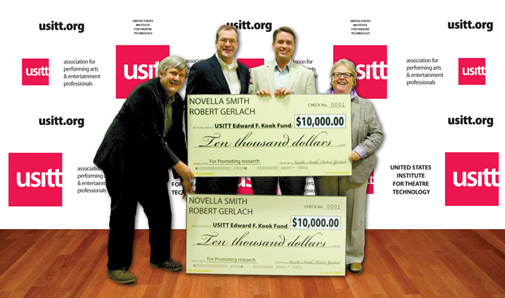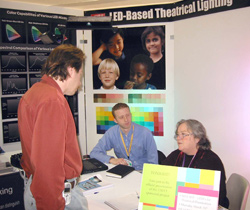News & Notices
Major Donation to USITT Spurs Research

Novella Smith and Rob Gerlach each presented USITT with a check for $10,000 in support of USITT's Edward Kook Fund at USITT's Annual Meeting on March 26 2014. From left are Rich Dunham, chair of the Grants & Fellowships committee, Dan Culhane, USITT Treasurer, Rob Gerlach and Novella Smith, founders of Selador.
USITT's ability to fund cutting-edge research took a huge step forward on March 26 when Novella Smith and Robert Gerlach made a $20,000 donation to the Edward Kook Fund. The gifts, announced at USITT's Annual Meeting in Fort Worth, were a surprise engineered by Ms. Smith and Mr. Gerlach as a way to show their appreciation for support they received in 2001 for their Development and Study of LED-Based Theatrical Lighting. That grant, coupled with an enormous amount of time and effort, helped lead to the creation of the Seledor series of LED lights.
Lea Asbell-Swanger, USITT's president, noted that one of USITT's strategic goals is to "promote and grow research that enhances the performing arts and live entertainment industry" and that the gift from Mr. Gerlach and Ms. Smith will be instrumental in showing the strong support for this type of research. View the check presentation below, or click here to view the video on YouTube.
Mr. Gerlach says the donation is "such a great moment for us, to be able to give back, a moment of coming full circle." Giving a donation to the Kook Fund was initially Ms. Smith's idea. Her first suggestion was "I think we should 'return' the money." Instead they are giving back double what they received.
The initial grant application they wrote was seeking support for research only, but Tim Kelly (then head of the Grants & Fellowship Committee) encouraged them to think more broadly, to jump start thinking about what might be possible. That generous and wonderful "no strings attached" support is why they want to pay it forward.

Rob Gerlach and his wife Kimberly at the booth he created to highlight the work on LEDs for the 2003 USITT Annual Conference & Stage Expo.
Going from the initial grant application to the actual production of a lighting instrument was an arduous process. Both say it was a passion that drove them forward, and the strong support of family and spouses is what made their dedication possible. "We put our families at financial risk" Ms. Smith noted, because even though they received positive feedback to their research and initial prototypes, they did not have a product to sell for several years.
Ms. Smith took a course at Rensselaer on LED manufacturing and was surprised to learn that it cost $1 million to create something new. Then, when she figured out their expenses and the time and resources the two had "donated" to the effort, that figure was just about correct.
"The USITT grant went for materials" Mr. Gerlach said, but the support continued. They had access to USITT's members and leadership for surveys and feedback, and were able to show their work at Stage Expo in 2003 where they demonstrated a prototype fixture that had been hand-assembled by Mr. Gerlach's entire extended family. Time was tight as he literally raced against highway closure and blizzard conditions to get the materials across Wyoming to Minneapolis for the event.

Novella Smith and Bryan Dunford showing their research and testing on human color perception and additive color mixing at USITT's Stage Expo in Minneapolis,Minnesota in 2003.
He vividly recalls giving a session about his work and expecting an empty room. Instead the place was packed. As he talked about the research on human color perception, that people actually see more than RGB, the audience sort of "ho-hummed" but then they turned off the lights and turned on that hand-assembled fixture and the audience gasped. "And we still did not have a single fixture to sell" Ms. Smith said.
Stepping from research to testing to more research to a final product was taxing, but they were able to find budding industrial engineers, electronic engineers, and people who understood DMX who all came together at "at just the right time for us," said Mr. Gerlach.
For USITT, the $20,000 donation also comes at a time when the organization is renewing its focus on research and development. Mr. Gerlach and Ms. Smith are both extremely supportive of that approach, and note that they hope that discussions about intellectual property and managing trade secrets will be part of the process.
To help support further research efforts, visit

